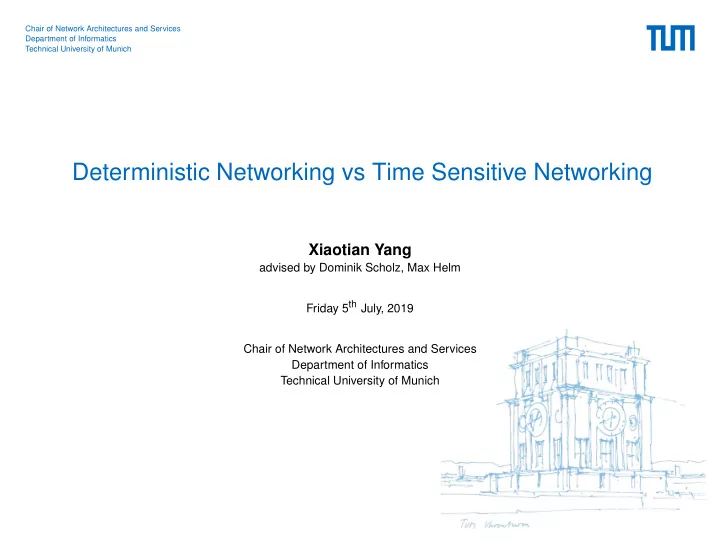

Chair of Network Architectures and Services Department of Informatics Technical University of Munich Deterministic Networking vs Time Sensitive Networking Xiaotian Yang advised by Dominik Scholz, Max Helm Friday 5 th July, 2019 Chair of Network Architectures and Services Department of Informatics Technical University of Munich
Outline Background Studies Overview of Time Sensitive Networking (TSN) Overview of Deterministic Networking (DetNet) Use Cases Future Studies Comparison of TSN and DetNet Bibliography X. Yang — Networking 2
Background Studies • Ethernet • simple connection mechanisms • cost-effectiveness • flexibility • Problem: Ethernet lacks deterministic latency properties of end-to-end flows • Ultra-Low Lantency Networking (ULL) • IEEE Time Sensitive Networking (TSN) • IETF Deterministic Networking (DetNet) X. Yang — Networking 3
Overview of Time Sensitive Networking (TSN) Features predecessor: Audio Video Bridging (AVB) industrial standards • Time Synchronization • Bounded Latency and Zero Congestion Loss • Ultra reliability Figure 1: TSN components and features [1] Figure 1 shows the main components and standards of TSN. X. Yang — Networking 4
Overview of Time Sensitive Networking (TSN) Time Synchronization-IEEE 802.1AS • TSN is designed to be a time-aware network • i.e. clock of all devices in TSN must be synchronized • with network-wide shared time reference, TSN is capable to fix transition delays and send packets at the time arranged X. Yang — Networking 5
Overview of Time Sensitive Networking (TSN) Bounded Latency and Zero Congestion Loss • Critical mechanism: Buffer allocation • Packet Latency is divided into 5 components: • Output delay • Link delay • Preemption delay • Processing delay • Queuing delay Figure 2: TSN Timing Model [5] • Buffers in the queue are allocated to compensate the variation of delay. X. Yang — Networking 6
Overview of Time Sensitive Networking (TSN) Bounded Latency and Zero Congestion Loss • Mechanism: Credit-Based Shaper (CBS) [3] • Class A: tight delay bound • Class B: loose delay bound Figure 3: Flow-chart illustration of the CBS opearation for a given queue [3] • CBS throttles each shaped traffic class to not exceed their preconfigured bandwidth limits. X. Yang — Networking 7
Overview of Time Sensitive Networking (TSN) Ultra Reliability • Core technique: Frame Replication and Elimination [5] (i) number the sequence of packets and replicate them in the network (ii) identify the redundant and eliminate packets in the destination Figure 4: Mechanisms of packet replication and elimination [5] X. Yang — Networking 8
Overview of Time Sensitive Networking (TSN) TSN Standards X. Yang — Networking 9
Overview of Deterministic Networking (DetNet) Features The charter of DetNet is similar to TSN but expand to higher Layer • Time Synchronization • Bounded Latency and Zero Congestion Loss • Ultra reliability Figure 5: OSI Model of TSN and DetNet [2] X. Yang — Networking 10
Overview of Deterministic Networking (DetNet) DetNet Internet Drafts draft-ietf-detnet Features -architecture DetNet architecture and the used techniques to carry real-time unicast/multicast data streams -data-plane-framework DetNet controller plane framework -dp-sol-ip DetNet IP Data Plane Encapsulation -dp-sol-mpls DetNet MPLS Data Plane Encapsulation -flow-information-model Integration over Layer 2 and Layer 3 -ip DetNet Data Plane: IP -ip-over-mpls DetNet Data Plane: IP over MPLS -ip-over-tsn DetNet Data Plane: IP over IEEE 802.1 Time Sensitive Networking (TSN) -mpls DetNet Data Plane: MPLS -mpls-over-tsn DetNet Data Plane: MPLS over IEEE 802.1 Time Sensitive Networking -mpls-over-udp-ip DetNet Data Plane: MPLS over IP -tsn-vpn-over-mpls DetNet Data Plane: IEEE 802.1 Time Sensitive Networking over MPLS -security Deterministic Networking (DetNet) Security Con- siderations -topology-yang Deterministic Networking (DetNet) Topology YANG Model -yang Deterministic Networking (DetNet) Configuration YANG Model RFC8557 was draft-ietf-detnet-problem-statement RFC8578 was draft-ietf-detnet-use-cases X. Yang — Networking 11
Use Cases TSN applicability in 5G Network IEEE Std 802.1CM specifies TSN Profiles for Fronthaul Figure 6: Fronthaul details with IEEE Std 802.1CM [1] X. Yang — Networking 12
Use Cases Use Case of DetNet [4] • Industrial Machine to Machine (M2M) • automation of manufacturing, quality control and material processing • M2M actors: Programmable Logic Controllers (PLCs) • supervisory PLC is achieved via critical control/data streams • Professional audio and video industry (ProAV) • transition to packet-based infrastructure and integration with IT infrastructure • interconnect Layer 2 and Layer 3, achieve broadcast over wide areas X. Yang — Networking 13
Future Studies • Time Sensitive Networking: • How to equip TSN with highly complex Infrastructure • Security and Privacy • Deterministic Networking • Interconnection between Layer 2 and Layer 3 • More concrete use cases X. Yang — Networking 14
Comparison of TSN and DetNet TSN DetNet Organizer IEEE TSN IETF DetNet OSI Layer Layer 2 Layer 3 Bounded Latency upper bound both upper and lower bound Data Plane / connect to other subnetworks including TSN Current Status has published a series of standards still not so mature, remains in draft stage X. Yang — Networking 15
Bibliography [1] "Time Sensitive Networking for 5G". [2] Time sensitive networks for industrial automation systems. [3] A. S. T. e. a. Ahmed Nasrallah. Ultra-Low Latency Networks: The IEEE TSN and IETF DetNet Standards and Related 5G ULL Research. 2018. [4] E. E. Grossman. Deterministic Networking Use Cases. unpublished, 2018. [5] N. Finn. Introduction to Time-Sensitive Networking. 2(2):22–28, 2018. X. Yang — Networking 16
Recommend
More recommend